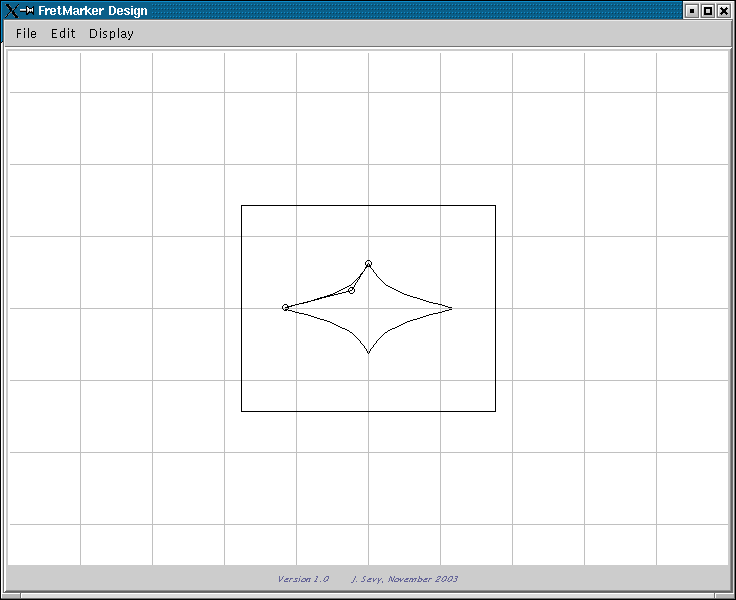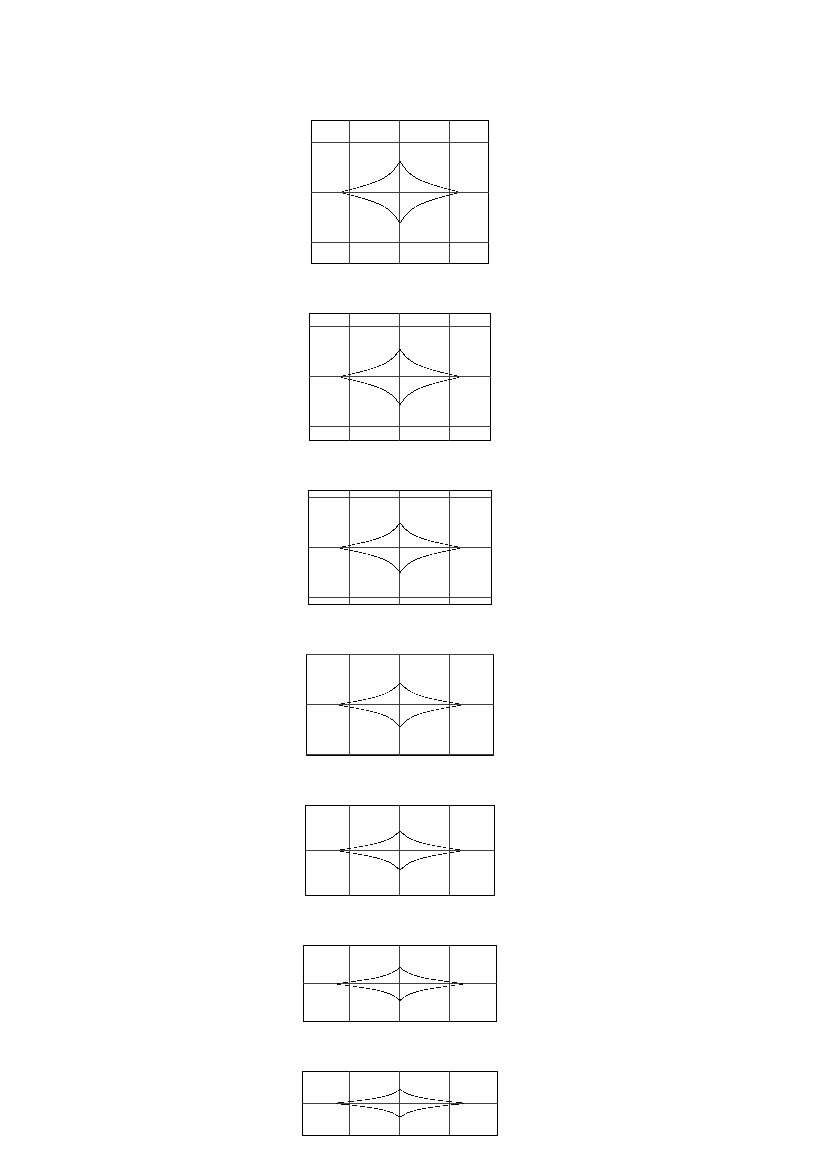Overview
Fretmarker Design is a Java application to aid in the design of unique guitar fret markers. Fret marker designs are specified with control points which indicate the general shape of the design; as the points are dragged to new positions, the fretmarker shape changes in the same direction. By moving (and adding and deleting) control points, a fretmarker design can be refined until it has the desired shape. A dialog allows the specification of the parameters of the guitar fretboard, including the scale length, the fretboard width at the the nut, and the fretboard width at the 12th fret. These parameters are used when the design is printed: the design is automatically scaled to produce templates for each of the frets which traditionally receive a marker (the F, G, A, B, C#, E, G, A, B, C# and E frets).

Starting
To start Fretmarker Design, either double-click on the FretmarkerDesign.jar file or type
java -jar FretmarkerDesign.jar
in a terminal window. When the Fretmarker Design application is opened, a blank design screen is displayed, with a rectangular outline that is the size of the space on the fretboard behind the low “F” fret. To begin a new design, select “New Design” from the “File” menu. The application will then be waiting for you to place the control points for the design; the points will be displayed sequentially wherever you click the mouse. When finished, select “Sketch curve” from the “Edit” menu. The curve corresponding to the control points will be drawn, along with the control polygon consisting of line segments connecting the control points, and the matching portions of the design if symmetry is selected in the Graphics dialog (discussed below). The design can now be refined by dragging the control points; as a point is dragged, the region of the curve in the vicinity of the point will change to follow the movement of the control point.
Notice that when a control point is clicked on with the mouse, it becomes highlighted; this is important when adding, deleting and altering the weight of points (see below), as the operation will apply relative to the currently selected point.
Some general design principles
- It takes relatively few control points to create a pleasing design.
- The curve will always pass through the first and last control points.
File Menu
The file menu contains items for opening, saving and printing designs.
New design
Select this to start a new design. After this item is chosen, the application will be waiting for you to click at the position of each successive control point, which will be drawn as a circle on the design. When finished placing control points, select “Sketch curve” from the “Edit” menu; the control-point addition process will be ended, and the curve and control polygon drawn on the design.
Open design
Open a previously saved design. Note that designs are saved in a proprietary XML format – only designs previously saved by the Fretmarker Design app can be opened.
Save design, Save design as
Note that the design parameters are saved as an XML file. This file is plain text, and can be inspected with a text editor if desired.
Export as PDF
Exports the design in PDF format so that it can be viewed and printed with any standard PDF application. Note that this format cannot be re-opened with the Guitar Design app, which uses its own proprietary format (see above under Save and Save As).
Export as ODG
Exports the design in ODG format so that it can be opened and modified in a standard Draw program such as LibreOffice Draw. Note that this format cannot be re-opened with the Guitar Design app, which uses its own proprietary format (see above under Save and Save As).
Export as SVG
Exports the design in SVG format so that it can be opened and modified in a standard vector graphics program such as Inkscape. This can also be used to generate gcode for CNC machining using an application such as the JSCut Inlay Assistant. Note that this format cannot be re-opened with the Guitar Design app, which uses its own proprietary format (see above under Save and Save As).
Print design
Select this item to print a design out. This will produce a complete set of scaled fret designs to be used as templates for producing the markers, as illustrated below. Note that the control points and control polygon (see below) are not printed

Edit Menu
The “Edit” menu contains items for displaying and altering the design.
Sketch design
The “Sketch design” item simply causes the design to be drawn onscreen; this is usually only used to stop the addition of control points and cause the design to be drawn when “New design” has been selected from the “File” menu.
Add point
This item is used to add a control point. This is useful for refining a design; adding a control point gives additional flexibility in specifying the shape of the design curve (though too many can make it difficult to create a smooth curve, resulting in unappealing lumps). It’s necessary to select the control point that the newly added point will follow before choosing the “Add point” menu item:
- Select the control point that the new point is to follow by clicking on one of the existing control points
- Choose the “Add point” menu item
- Click at the position for the new control point; the new point will be drawn at this position, and the curve will be altered accordingly
The newly added point can be dragged to refine the curve shape.
Delete point
This item is used to remove a control point. It’s necessary to select the control point to be deleted before choosing the “Delete point” menu item:
- Select the control point to be deleted by clicking on one of the existing control points
- Choose the “Delete point” menu item; the selected point will be deleted, and the curve will be altered accordingly
Alter weight
This item is used to affect the amount of influence a control point has on the curve. The default weight of a control point is 1: if its weight is increased to 2, the curve will be drawn more closely to the point; if the weight is increased to 3, the curve will pass through the point, and may even forma a cusp (sharp corner) at the point. It’s necessary to select the control point whose weight is to be altered before choosing the “Alter weight” menu item:
- Select the control point whose weight is to be altered by clicking on one of the existing control points
- Choose the “Alter weight” menu item; a dialog will appear in which you can select the point’s weight
- When the dialog is closed, the curve will be redrawn to reflect the control point’s new weight
Move Curve
This will change the cursor to a standard “hand” cursor and allow you to drag the fretmarker design to a new position. Note that if symmetry has been selected this can lead to unexpected results, as the symmetry is always about the center of the fret rectangle.
Scale Design
This allows you to enlarge or shrink the fretmarker design by the specified percentage.
Undo, Redo
These will undo and redo previously applied operations.
Display Menu
The Display menu contains items that affect the display of the design
Control points
When checked, control points will be displayed. This will usually be desired.
Control polygon
When checked, the sequence of control points will be connected with line segments. This may be helpful, but can often be left unchecked.
Curve
When checked, the curve will be displayed. This will usually be left checked.
Show display dialog
This item brings up the display dialog, with the following items:
- Units: allows quantities to be specified in either inches or centimeters
- Grid: selects whether a rectangular grid should be drawn in the display window
- Grid width: specifies the spacing of the grid
- Design window scale factor: specifies the fraction of actual size used for the onscreen display
- Symmetry: specifies whether the design should be symmetric
- Horizontal symmetry: make the design symmetric about the horizontal axis
- Vertical symmetry: make the design symmetric about the horizontal axis
- Radial symmetry: make the design radially symmetric, i.e., symmetric through the center point
- Fretboard parameters: these are used to produce properly scaled templates when printing
- Fretboard scale length: the length of the strings, from saddle to nut
- Fretboard width (nut): width of the fretboard at the nut
- Fretboard width (12th fret): width of the fretboard at the12th fret
- Layout type: Whether to create fretmarkers for a standard guitar layout or ukulele layout
Show Preview
Display the scaled fretmarkers in a separate window (which can be scrolled and enlarged using the mouse wheel).